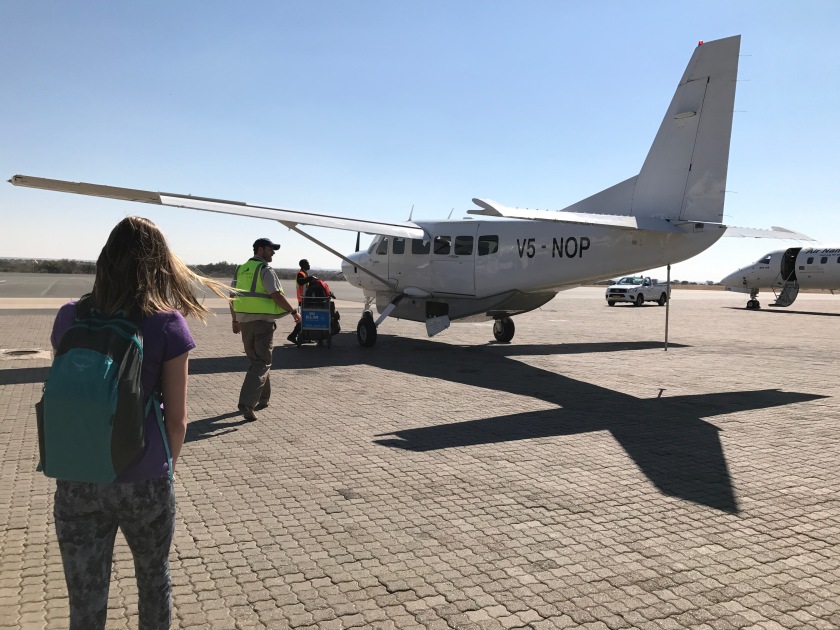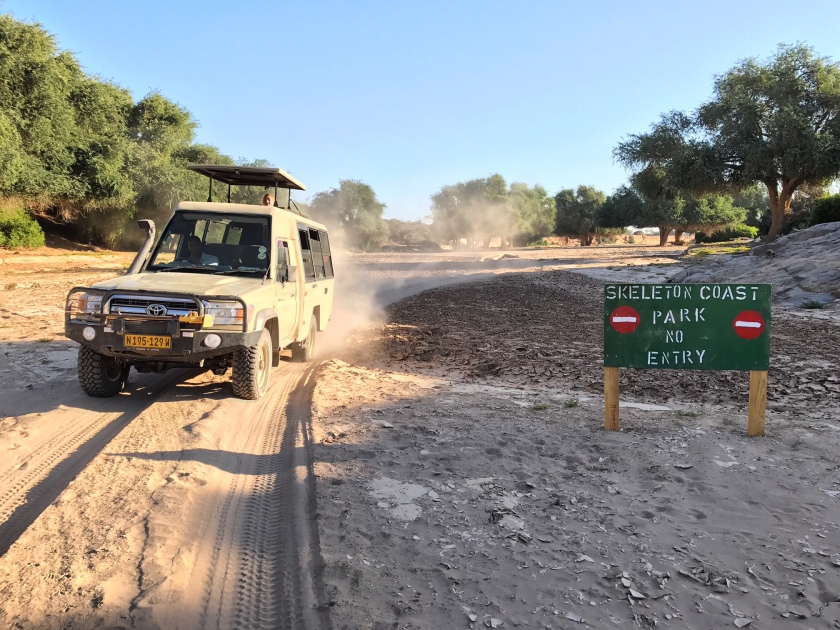We flew into Desert Rhino Camp in a Cessna, the first small airplane I’ve ever flown in. There were only nine seats and we flew low over the landscape so we could see the detail below. Desert Rhino Camp is in the Palmwag Concession in northwest Namibia, a remote desert area known for its desert adapted wildlife. It was about an hour from Windhoek to a small airstrip where we switched to another Cessna that took us to the camp. We landed on a dusty airstrip and our guide picked us up in a safari jeep. His said his name was Bons. He drove us to camp, and when we arrived we were greeted by singing. All of the staff were standing outside and singing us a welcome song.

Bons took us out for a sunset drive around the camp before dinner, we saw Hartman zebras, one of the three species of zebras, these ones are unique because their stripes go down to their hooves but they have white bellys. We also saw oryx and lots of springbok. The trails were very bumpy and Bons called it the ‘African massage’. The desert landscape here is very dry, there is very little water for the animals, especially since it is winter now and the riverbeds are dried up. There are a few springs, but the animals really have to work for their water. Oryx are a great example of an animal adapted for the desert, because they can get a lot of their water from the grasses and tubers they eat.

The next day was our first day of tracking desert adapted rhino, which here are black rhinos. This area is the only area left in the world of free roaming rhinos of anykind white or black which make it very special to try and track. Save the Rhinos Trust is working in partnership with Wilderness Safaris who run Desert Rhino Camp to monitor and protect and save the rhinos. This area has had less poaching than national parks like Etosha. While we were in Windhoek, we read in the newspaper about a recent pregnant rhino being killed. Rhino poaching is still a huge problem in Namibia despite its conservation efforts. Rhino horns are worth a lot of money and people are still willing to take the risk. Rhino horn prices have risen to over $100,000 a kg, despite it being made up of the same stuff as our fingernails. This is mainly because of people in Vietnam that believe rhino horn powder is a cure all for many things including hangover cures and cancer.
We woke up at 5am to have breakfast and get on the road by sunrise with Bons. The trackers were already out and looking for signs of the rhinos from the night before, and communicating with Bons. We were driving towards what they called Zone 3. As we drove we saw more oryx, springbox, Hartman zebra, and our first desert adapted giraffes. Bons showed us tracks of a leopard in the dry riverbed and rhino tracks from he said where fresh from that morning which are very large and three-toed. We also found elephant and rhino scat which looks almost the same, but Bons showed us that when you break it apart the sticks and grass have been chewed at a 45 degree angle if its a rhino because of their teeth. Also, that it is basically safe to touch elephant and rhino scat because they are grass eaters and has been processed so much that it’s harmless, unlike carnivore scat which is full of bacteria because they are meat eaters. I still didn’t want to touch it though.
We drove for about an hour on very rough rocky roads, and suddenly Bons stopped the jeep and took his binoculars out… far away on the mountain, he spotted two white dots….rhinos. He called the trackers on the radio and immediately made a plan to get up to where they were without scaring them away. The idea is to get downwind so that we could approach closer on foot. That is the amazing thing about meeting up with Save the Rhino Trust trackers is being able to get close to the rhinos on foot and observe how the trackers and rangers work to protect and monitor the rhinos.
We parked the cars and watched their behavior first before approaching on foot. We then walked over and observed the two rhinos for about 15 minutes. It was a mother and her adolescent calf, known as Top Notch and Troy. Rhinos eyesight is very poor, but their hearing and their smell is very good. We stayed very quiet and the trackers and rangers used hand signals to communicate. Top Notch snorted loudly several times and moved as though she was going to walk towards us, but eventually they both trotted off. One ranger stayed back and took notes while we went back to the jeep.

Later we learned from Samson, the director of Save the Rhino Trust, that they don’t publicly discuss how many rhinos there are in the area, or where they are, so as to not give poachers any potential information or leads that could aid them. This is much different than how conservation works with big cats who are often radio collared to aid in tracking and monitoring numbers and territory. There are approximately 5,000 black rhinos left in the world and they are all concentrated in southern Africa with the last free roaming herd outside of a game park in Namibia.
We also saw lots of desert adapted giraffe, black back jackal, and ostrich while we were driving around.
At dinner, Winnie and Nicole, announced dinner in English and in Damara, the click language. A local tribal language based on clicks. The manager was sitting next to us at the table and told us how similar the words are for spoon, elephant, blue, and wind in Damara and joked that he is too scared to learn the language for fear he would ask for an elephant to eat his soup with. After dinner when it was dark, a spotted hynena came walking by the edge of the camp and that night in bed we could hear several ‘laughing’.
The next day we went out again and were lucky enough to find two more rhinos, Don’t Worry and an unnamed female that had traveled in from another area. This was a harder approach, we had to walk for thirty minutes over very rocky ground to reach the rhinos downwind. We were more exposed but I felt very safe with Bons who stayed close to me and the rangers signaled when they felt that we needed to move when the wind direction changed or the rhinos were moving too close. The unnamed female watched us intently, walked around in circles, pawed at the ground a few times, and false charged a few times which was a little scary.

We turned to observe Don’t Worry who is 27 year old, born in 1990, the year of Namibian’s independence. Bons said, he is the one rhino he feels comfortable closing his eyes around, because he’s so predictable and super chill.
We decided to go out one last time to try and see the rhinos the morning of our departure and got lucky. We were able to see the unnamed female again in a different location. She was in a riverbank, it was another long walk in, but much easier. We got very scared when she almost charged us and even made the trackers a little nervous.

 We drove back to camp and interviewed Bons about his life and working at Desert Rhino Camp as a guide and had time for one last game of chess. He says he isn’t very good, but he is actually an expert. He taught me a few tricks. Winnie, tried to teach me the word for spoon in Damara, the click language, but I really struggled to make the sound of the click at the same time as the word.
We drove back to camp and interviewed Bons about his life and working at Desert Rhino Camp as a guide and had time for one last game of chess. He says he isn’t very good, but he is actually an expert. He taught me a few tricks. Winnie, tried to teach me the word for spoon in Damara, the click language, but I really struggled to make the sound of the click at the same time as the word.
As we got into the jeep to leave, the staff came out to sing a song and Bons told my mom to get her camera out to video. Then he jumped out of the car and told them to sing the Desert Rhino Song and he joined in. Then they really got going and one of the guys ran off to grab his drum and the cook said, “that guy’s obsessed with music”. They sang two more songs for us, and Bons showed us his dance moves. It was hilarious and made me want to stay longer.
I miss them all already and can’t wait to come back again!!!!!!!!!!!!!!!!!!!!!!!!!!!!!!!!!!!!!!!!!!!!!!!
























 We drove back to camp and interviewed Bons about his life and working at Desert Rhino Camp as a guide and had time for one last game of chess. He says he isn’t very good, but he is actually an expert. He taught me a few tricks. Winnie, tried to teach me the word for spoon in Damara, the click language, but I really struggled to make the sound of the click at the same time as the word.
We drove back to camp and interviewed Bons about his life and working at Desert Rhino Camp as a guide and had time for one last game of chess. He says he isn’t very good, but he is actually an expert. He taught me a few tricks. Winnie, tried to teach me the word for spoon in Damara, the click language, but I really struggled to make the sound of the click at the same time as the word.